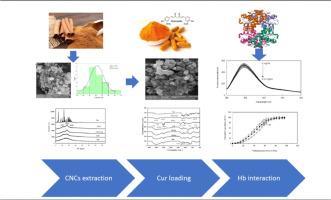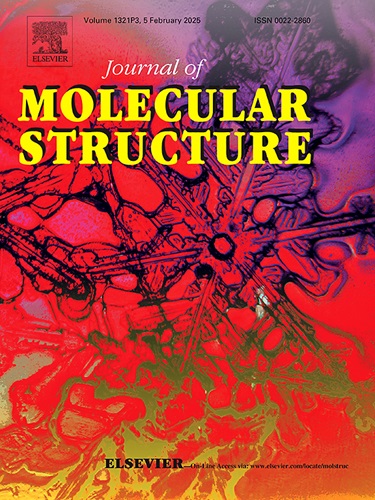Preparation of cellulose nano crystals from cinnamon stick, curcumin delivery and interaction with human hemoglobin protein: A novel view of the oxygenation hemoglobin
IF 4
2区 化学
Q2 CHEMISTRY, PHYSICAL
引用次数: 0
Abstract
Curcumin (Cur), a natural phenolic compound, exhibits promising therapeutic properties including anti-cancer and anti-inflammatory effects. However, its limited bioavailability hinders its efficacy when administered alone. To address this challenge, this study explores the use of cellulose nano crystals (CNCs) derived from cinnamon stick via acid hydrolysis as carriers for Cur. The CNCs were thoroughly characterized, and Cur was successfully bound to them. Structural and morphological analyses of the CNCs-Cur complex were investigated applying Fourier-transform infrared spectroscopy (FTIR), X-ray diffraction (XRD), transmission electron microscopy (TEM), and scanning electron microscopy (SEM). Interaction studies between hemoglobin and the CNCs-Cur complex were carried out using various fluorescence spectroscopic techniques. Fluorescence spectroscopy revealed hemoglobin fluorescence quenching by the CNCs-Cur complex, with Stern-Volmer constants determined at different temperatures indicating static mechanism for the quenching. Synchronous fluorescence spectroscopy provided insights into the molecular micro-environment surrounding chromophores, and the distance between the CNCs-Cur complex and hemoglobin fluorophores was calculated using Forster's non-radioactive energy transfer theory (FRET), yielding a distance of <7 nm. Circular dichroism (CD) analysis indicated structural changes in hemoglobin upon the interaction with CNCs-Cur, while oxygenation techniques were employed to investigate oxygen binding, release, and transfer in hemoglobin. This comprehensive investigation sheds light on the potential of CNCs as effective carriers for curcumin, offering valuable insights into their interaction with biological molecules.

桂枝纤维素纳米晶体的制备、姜黄素的输送以及与人血红蛋白的相互作用:氧合血红蛋白的新视角
姜黄素(Cur)是一种天然酚类化合物,具有很好的治疗效果,包括抗癌和抗炎作用。然而,由于姜黄素的生物利用度有限,单独给药会影响其疗效。为了应对这一挑战,本研究探索了使用从肉桂棒中通过酸水解提取的纤维素纳米晶体(CNCs)作为莪术的载体。研究人员对 CNCs 进行了全面的表征,并成功地将 Cur 与 CNCs 结合。应用傅立叶变换红外光谱(FTIR)、X 射线衍射(XRD)、透射电子显微镜(TEM)和扫描电子显微镜(SEM)研究了 CNCs 与 Cur 复合物的结构和形态分析。利用各种荧光光谱技术对血红蛋白与 CNCs-Cur 复合物之间的相互作用进行了研究。荧光光谱显示血红蛋白荧光被 CNCs-Cur 复合物淬灭,在不同温度下测定的 Stern-Volmer 常数表明淬灭机制是静态的。同步荧光光谱分析有助于深入了解发色团周围的分子微环境,利用福斯特非放射性能量转移理论(FRET)计算出 CNCs-Cur 复合物与血红蛋白发色团之间的距离为 7 nm。圆二色性(CD)分析表明,血红蛋白在与 CNCs-Cur 作用后发生了结构变化,同时还利用氧合技术研究了血红蛋白中氧的结合、释放和转移。这项全面的研究揭示了氯化萘作为姜黄素有效载体的潜力,并对氯化萘与生物分子的相互作用提供了宝贵的见解。
本文章由计算机程序翻译,如有差异,请以英文原文为准。
求助全文
约1分钟内获得全文
求助全文
来源期刊

Journal of Molecular Structure
化学-物理化学
CiteScore
7.10
自引率
15.80%
发文量
2384
审稿时长
45 days
期刊介绍:
The Journal of Molecular Structure is dedicated to the publication of full-length articles and review papers, providing important new structural information on all types of chemical species including:
• Stable and unstable molecules in all types of environments (vapour, molecular beam, liquid, solution, liquid crystal, solid state, matrix-isolated, surface-absorbed etc.)
• Chemical intermediates
• Molecules in excited states
• Biological molecules
• Polymers.
The methods used may include any combination of spectroscopic and non-spectroscopic techniques, for example:
• Infrared spectroscopy (mid, far, near)
• Raman spectroscopy and non-linear Raman methods (CARS, etc.)
• Electronic absorption spectroscopy
• Optical rotatory dispersion and circular dichroism
• Fluorescence and phosphorescence techniques
• Electron spectroscopies (PES, XPS), EXAFS, etc.
• Microwave spectroscopy
• Electron diffraction
• NMR and ESR spectroscopies
• Mössbauer spectroscopy
• X-ray crystallography
• Charge Density Analyses
• Computational Studies (supplementing experimental methods)
We encourage publications combining theoretical and experimental approaches. The structural insights gained by the studies should be correlated with the properties, activity and/ or reactivity of the molecule under investigation and the relevance of this molecule and its implications should be discussed.
 求助内容:
求助内容: 应助结果提醒方式:
应助结果提醒方式:


